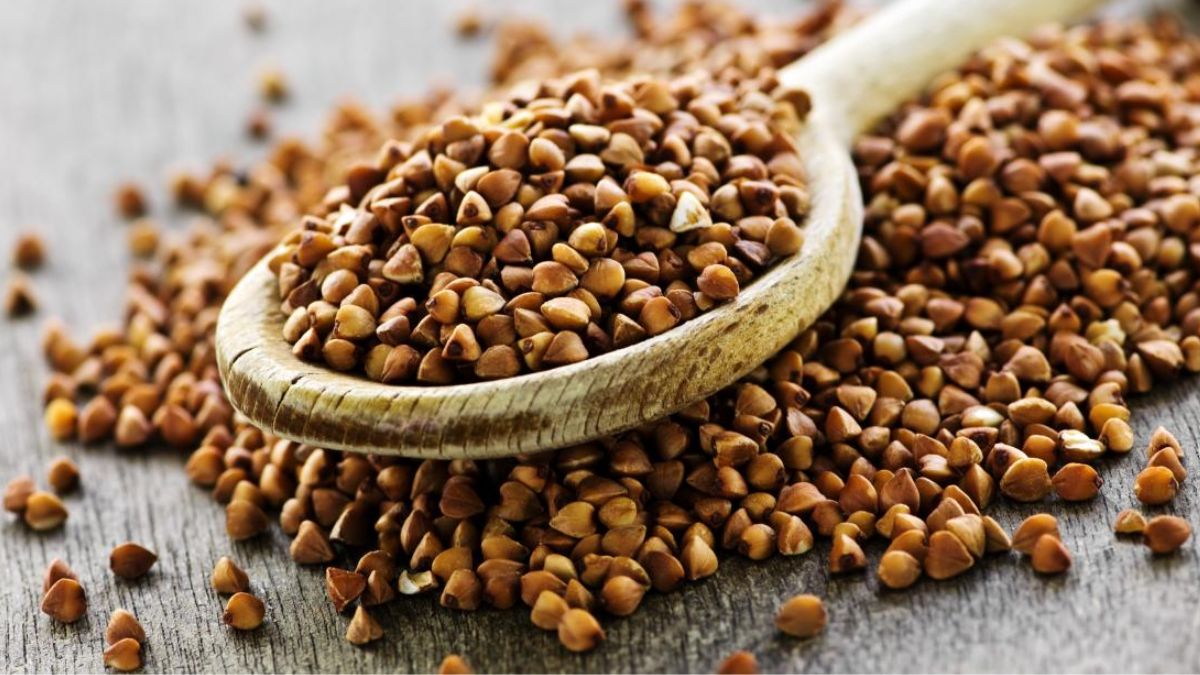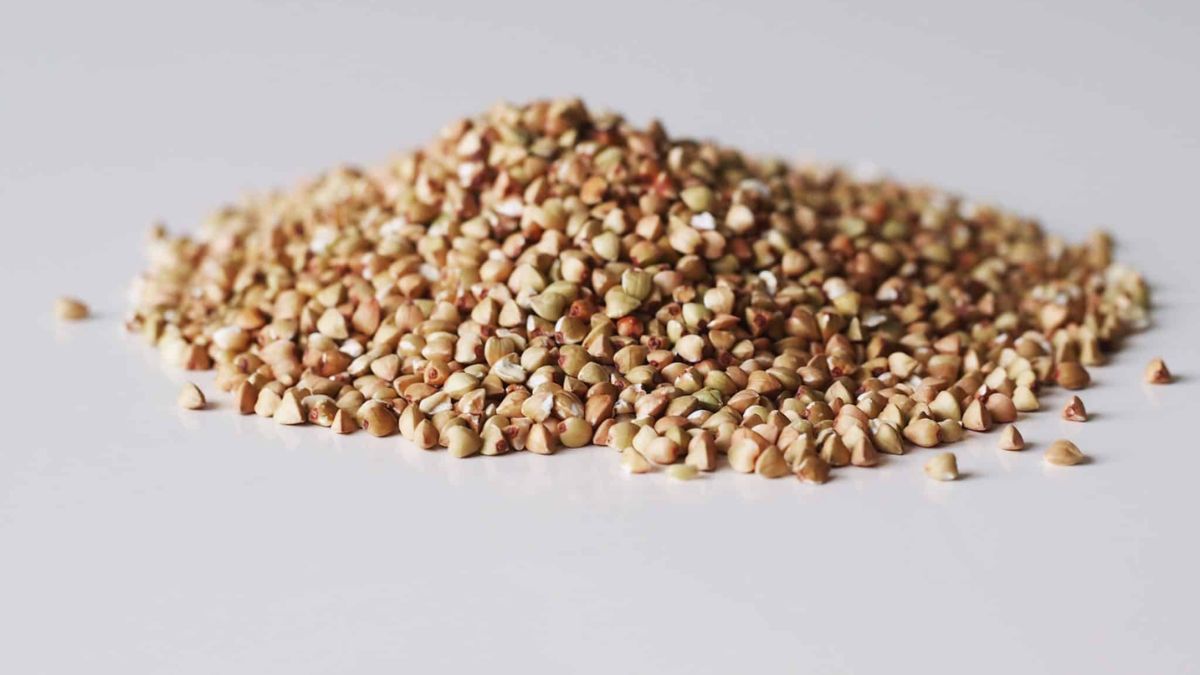Buckwheat groats, the seeds of a flowering plant, are often found in raw food diet recipes and in foods like buckwheat flour, soba noodles, and kasha, which are roasted groats. The Fagopyrum esculentum plant, related to rhubarb and sorrel, is where buckwheat comes from, and buckwheat comes from a similar plant called Fagopyrum tataricum, which grows in Asia.
Buckwheat has been grown for over 8,000 years, sometimes called an “ancient grain.” It was a common crop worldwide before nitrogen fertilizer was used to grow more corn and wheat in the 20th century. Because of this, these crops were planted in fields that used to grow buckwheat. This caused buckwheat production to drop dramatically, but it is still a big part of the food in Eastern Europe.
What is Buckwheat?
Some people get confused by the name “buckwheat.” This gluten-free seed has nothing to do with wheat, but it can be cooked the same way as wheat grains like bulgur, wheat berries, spelled, and freekeh. Even though it is more expensive, buckwheat is still a cheap way to get high-quality protein. The triangular kernels are called “pseudocereals,” a type of seed from a plant that isn’t grass but is usually eaten like a grain. Amaranth and quinoa are also pseudocereals.
Buckwheat is gluten-free because it has nothing to do with wheat. Gluten is a protein found in wheat and a few other bowls of cereal but not in the seeds of flowering plants. Even though buckwheat doesn’t have gluten, it can get contaminated if processed and packed in the same place as wheat. Buckwheat can also make some people sick.
How to Cook Buckwheat?
Rinse buckwheat, and then cook it in twice as much water as buckwheat. Bring the water to a boil, then add the buckwheat groats and some salt. Let it come back to a boil, then cover the pot, turn the heat down to a simmer, and cook it for about 15 minutes, or until it’s soft.
Buckwheat groats can be ground into flour and used to make noodles, crepes, pancakes, and many other gluten-free foods. Buckwheat flour is the main ingredient in Japanese soba noodles, but many brands also use wheat flour, so packaged soba noodles may not be gluten-free. Raw buckwheat groats add texture and nutrition to granola, cookies, cakes, crackers, and other foods like bread for people who eat only raw foods. You can also grow sprouts from them to put on sandwiches and salads. With a sprinkle of raw buckwheat groats, anyone can give yogurt, soup, or salad a satisfyingly nutty crunch. Buckwheat, which turns gelatinous when mixed with water, is also a good baking binder.
Ingredients
- 1 cup toasted buckwheat groats
- 1 1/2 cups filtered water
- Two tablespoons of unsalted butter – or to taste
- 1/2 teaspoon fine salt – or to taste
Instructions
- Put 1 cup of uncooked buckwheat in a fine-mesh strainer and rinse it under cool running water until the water runs clear. Drain it well.
- Over high heat, bring 1 1/2 cups of cold water, two tablespoons of unsalted butter, and 1/2 teaspoon of fine salt to a boil in a small pot with a lid.
- Stir the buckwheat into the boiling water and put the lid on the saucepan. Bring back to a slow boil, then turn the heat down to low. Cook for 13 to 15 minutes, or until the water is gone. (Like rice, it should hiss while it’s cooking, and when it’s done, it will be quiet.) Buckwheat will take 2-3 minutes to cook in pans that don’t stick.
- Take the buckwheat off the heat and let it sit for 10 minutes with the lid on. Use a fork to fluff, and then serve. This amount of buckwheat will make about 3 cups once it is cooked. If you want, add more butter, but don’t stir too much, or the cooked buckwheat will get mashed.
- Once it has cooled, you can eat it immediately or put it in the fridge. Don’t leave for a long time at room temperature.
What does it Taste Like?
Buckwheat has a stronger flavor than common grains like wheat, oats, and rice, which may make it seem slightly bitter. The naturally toasty, nutty taste gets stronger when the food is roasted.
Where does Buckwheat Come From?
There are many kinds of buckwheat, but the two most well-known are Tartary buckwheat (Fagopyrum tartaricum) and common buckwheat (F. esculentum). Buckwheat comes from the same family of plants like rhubarb and sorrel. It lives in western China, Tibet, and the eastern part of India. It also grows well in the U.S., Southeast Asia, Russia, and many countries in Central and Eastern Europe. Buckwheat grows quickly, does well in cold climates and high altitudes, and doesn’t die from drought, making it a great crop to grow in many places.
Raw buckwheat groats, usually beige or light green, are the seeds. Even though there are different kinds, Samantha Murdoch, a registered dietitian at Lenox Hill Hospital in New York, says, “nutritionally, there is no difference between the two.”
Where to Buy Buckwheat?
Most grocery stores sell buckwheat groats in packages and look in the baking and cereal aisles or near the rice and beans. Buckwheat flour should be in the baking aisle or maybe with international products. Buckwheat groats can be bought in bulk at some health food stores. Find kasha, which is buckwheat groats that have already been toasted, near the breakfast oats. You can also buy different buckwheat products online, from raw groats to crackers.
Storage Tip
Dry buckwheat groats should be kept in an airtight container away from light, heat, and moisture, just like any other grain. The problem is that it doesn’t last very long. The Whole Grains Council says that buckwheat groats should be used within two months of buying them. Buckwheat flour should also be kept in an airtight container and used immediately or within a month. Putting it in the freezer makes it last twice as long.
Health Benefits of Buckwheat
Buckwheat is good for you in a lot of ways. Many doctors and nutritionists praise this seed for a good reason. “Generally, a diet with more fiber can help you avoid heart disease, diabetes, high cholesterol, and weight gain. Murdoch says that adding buckwheat to the diet is a great way to reduce chronic conditions because it is an important part of a healthy diet.
Antioxidants are naturally occurring substances that protect the body from free radicals, which can cause heart problems, cancer, and other long-term diseases. Buckwheat has a lot of antioxidants that may help protect the heart, lower blood pressure and cholesterol, and provide other health benefits. “It has anti-inflammatory and anti-cancer properties because it has flavonols, rutin, and phenolic acids.”
Murdoch says that manganese is a very important antioxidant that helps the body do many things, like break down amino acids, cholesterol, glucose, and carbohydrates.
Heart Protection
Buckwheat has a lot of antioxidants that are good for the heart. “It not only has fiber, protein, vitamins, and minerals, but it also has antioxidants called flavonoids, which are great for heart health. D-chiro-inositol, similar to a vitamin, is another important part of buckwheat. It seems to help lower blood pressure and keep blood sugar levels in balance. There is more of this compound in buckwheat than in any other food.
Cholesterol Control
Buckwheat has a lot of fiber, which helps lower cholesterol by cleansing your digestive tract. Murdoch says, “Fiber acts like a scrub brush in your GI tract and stops cholesterol and other fats from being absorbed.” Adding high-fiber foods like buckwheat or whole grains to your diet can help lower your risk of heart disease, help you lose weight, and lower your cholesterol.
Blood Pressure
Buckwheat is full of magnesium, an important mineral that helps protect the body in many ways. “Magnesium keeps bones healthy and helps muscles and nerves work, which can help prevent high blood pressure by keeping the heart’s rhythm regular.”
How to Eat Buckwheat?
Buckwheat can be cooked like rice or quinoa, or it can be eaten as a breakfast porridge. “People should try something different and eat this seed,” Buckwheat flour is used to make crepes and soba noodles, both common foods in Japan. “You can even grind the grain into flour and make pancakes with it,”
Toasted buckwheat has a mahogany color and smells more like nuts than buckwheat groats. In the United States, it is often called kasha, and people often eat toasted buckwheat in place of granola or as a crunchy, healthy salad topping. In Russia and Ukraine, the word “kasha” can mean different boiled and toasted grains, such as buckwheat.
To add buckwheat into the diet, try the following recipe ideas:
Breakfast – Buckwheat porridge is a healthy alternative to most breakfast cereals. You can also use buckwheat flour to make pancakes that go well with berries.
Lunch- Buckwheat groats are a great thing to put in a salad. Before adding them to the salad, boil the buckwheat groats in salted water.
Dinner- To add buckwheat to a stir-fry, mix the groats with an egg and fry them over medium heat for a few minutes before adding other ingredients.
Dessert- Buckwheat muffins are a tasty, gluten-free option for dessert.
Potential Downsides
Some people are allergic to buckwheat, but other than that, there are no known bad effects of eating it in moderation.
Buckwheat allergy- People who eat a lot of buckwheat and eat it often are more likely to be allergic to it. People who are already allergic to latex or rice are more likely to have this allergy. This is called “allergic cross-reactivity.” Some of the symptoms are rashes, swelling, stomach pain, and, in the worst case, severe allergic shock.
Conclusion
Buckwheat is a seed, even though its name sounds like it is wheat or grain. It is sometimes called grain and a pseudocereal to confuse things. But buckwheat is more like amaranth, millet, or quinoa. These are tasty, healthy seeds that are gluten-free and full of fiber, but they are often grouped with grains.
Even though it sounds like wheat or grain, buckwheat is a seed. To make things even more complicated, it is called a pseudocereal and is often called a grain. But buckwheat is more like amaranth, millet, or quinoa, which are also seeds but are more like grains because they are full of fiber and don’t have gluten.

